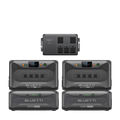Your cart is empty
Shop our productsWhether using a smartphone, electric vehicle, or laptop, they rely in part on amp-hour to indicate how long the device can run. While technical, understanding amp hour can help you understand how a battery operates. It can help you understand how electricity is generated, distributed, and transformed.
This article delves into amp-hours, how it works, and its application. It will also delve into how it plays a pivotal role in determining the endurance and reliability of our modern, battery-powered world.
What is an amp?
Amp is the measure of the rate at which electrons flow through an object or conductor. The higher the amperage a conductor has, the more electrons can flow through it. In short, it is an indicator of how much energy can flow through an object.
What is an amp hour (Ah)?
Ampere hours is the amount of energy in a battery that enables 1 amp to flow for one hour. Ideally, it indicates the amount of amperage the battery can provide in an hour. The higher the rating the more powerful the battery.
For example, a 3 Ah battery will provide three amps of current per hour. Similarly, a 5 Ah will provide five amps of current per hour. So, if your device requires one amp to run, the battery will provide up to five hours of power.
Ah is used to rate large batteries while small batteries such as AAA and AA use the milliampere hours (mAh) rating. Whether mAh or Ah, several factors affect how long either will last. They include the following:
- Battery capacity: The battery capacity no doubt affects how long Ampere-hours will last. If the battery has a higher capacity, it will last longer and vice versa.
- Temperature: Temperature also affects how long Ah will last. A battery running in extreme cold conditions tends to discharge faster. On the other hand, high temperatures cause a battery to degrade quickly.
- Cycling patterns: Ideally, each battery has a set cycle lifespan. The more frequent the charge and discharge cycle, the shorter the battery lifespan, meaning Ah will be shorter. If the charge and discharge cycle is infrequent, the Ah will last longer.
- Battery chemistry: Batteries come in different chemistries such as nickel-metal hydride, lead-acid, and lithium-ion. Some have a longer Ah while others have a shorter one.
Other factors include depth of discharge, load draw, battery management systems, environmental, and maintenance.
Ampere hour can also be used in electrochemical systems. With electrochemical systems, plating thickness is proportional to the integration of current over a specified time period.
Having a preset ampere-hour rating ensures uniform plating thickness and uniformity in quality. These requirements are crucial for precision electroplating applications, making Ah an ideal option. Some applications that use electroplating include silver, platinum, and gold.
How to calculate amp hour rating
An ampere-hour is the product of the current and the time taken for a battery to fully discharge. This can be represented as:
Amp hour (Ah) = Current (I) x Discharge Time (T)
For example, if a battery has a 15 A current and discharges in three hours, we can calculate its Ah using the following formula:
Amp hour (Ah) = 15 x 3 which is 45Ah
You can find the ampere-hour rating on any battery. However, starting batteries do not have the rating as they are not meant to provide continuous power in Ah.
Common Ah ratings
Ah rating depends on the battery’s chemistry and purpose. For solar batteries used in off-grid or grid-tied solar power systems, they often range between 50Ah and 500Ah. For example, the BLUETTI B300S Expansion Battery has a 60Ah rating, meaning it can supply a 60 amperes continuous current for one hour.

Typical rechargeable lithium-ion batteries have a 3,200mAh rating. They can therefore discharge 3.2A per hour. Starting batteries have a 10-hour rating because they are used faster.
Industrial batteries have a six-hour rating since they have a more rigorous duty cycle. You can also find batteries with a 100-hour rating. This rating allows electricians to calculate the battery capacity for long-term backup requirements. Most car batteries are rated at 70 Ah.
To define a lead-acid battery ampere hour, manufacturers often drain the battery to 0% over a specific period. The level of amperage it takes to get the battery to zero at this period is the ampere-hour rating.
What is Milliampere Hour?
Milliampere or mAh is 1,000th of 1 Ah. It measures how much current a battery discharges over one hour. It also indicates how long a battery can operate before recharging.
If a battery has a higher milliampere hour, it indicates a long battery runtime or storage capacity. However, a higher milliampere does not indicate a higher speed.
Difference Between Volts, Ohms, and Amps
What Is a Volt?
A volt is the measurement of the electric pressure at which electricity flows through a system. It can also be described as the speed of electrons as they move through a conductor.
In the United States, utility companies deliver electricity at two different voltages: 240 volts and 120 volts. This is because home appliances consume different voltages.
For example, large appliances such as clothes dryers, air conditioning units, and HVAC systems operate at 240 volts.
Smaller devices like TVs, light bulbs, and computers need at least 120 volts. With the BLUETTI B230 Expansion Battery, you can power different large and small appliances with a rating of 120 volts.
What Is an Amp?
Like voltage, amperage is the measurement of electricity running through a circuit. It is the rate at which current is flowing through the circuit or the electrons moving through a wire. It is listed using units called amperes, which is a name coined by French physicist Andre-Marie Ampere.
Most home service panels or breaker boxes have different circuit breakers listed as 30 amps, 20amps, and 15 amps. As you’d expect, the larger the amperage, the more electricity can flow through the circuit.
As such, large appliances such as dry cleaners, dryers, and air conditioners will be connected to a 30-amp circuit. However, most home outlets are connected to 20 or 15-amp circuits.
And if you try to run many appliances on the same circuit, the breaker will trip and cut off power to protect the wiring from overheating.
What Are Ohms?
Ohms is the measure of resistance in a wire. Wires are made of copper or aluminum. They have a natural resistance that slows the flow of electrons. Besides, electrical appliances have their resistance. To measure this resistance, electricians use Ohms.
What is The Difference Between AC and DC Amps?
Both DC and AC amps are used to measure electrical current. They however have distinctive differences. Let’s look at them.
Waveform
AC has a sinusoidal waveform, meaning it has a smooth continuous oscillation between negative and positive values. The frequency or rate of cycles depends on the source. In the United States, this is 60 Hz.
DC amps form a straight line at a constant value, indicating consistent flow of current in one direction.
Current Flow
Unlike DC, AC changes direction, flowing back and forth in a sinusoidal waveform. As such, the current changes direction before reaching the negative and positive values. DC on the other hand flows in one constant direction and does not reverse direction over time.
Use cases
AC is used in household electricity and power distribution systems since it is easy to generate and distribute. It is also stabler than DC.
For example, the BLUETTI EP900 + B500 Home Battery Backup provides a stable current to power 120V and 240V devices. It is compatible with most home devices such as TVs, air conditioners, and HVAC devices.

With a guaranteed lifespan of over 10 years, you are sure of constant powering of devices. Thanks to its IP65 rating, you can install it inside or outside your house.
DC is used in specialized applications, electronics, and batteries. For example, laptops and smartphones operate on DC power.
Voltage Levels
AC voltage can vary in amplitude over time since it has a sinusoidal waveform. The voltage level alternates between negative and positive peaks. DC voltage remains constant in polarity and magnitude over a period of time.
Safety
AC is considered safer for long-distance power transmission because it can be transformed to different voltage levels using transformers. It does not cause electrical shock due to changes in direction.
While not as safe as AC, DC can be safer for certain electronic devices as it eliminates the risk of electromagnetic interference (EMI), which is present in AC.
Final Thoughts
As you can see, amp hour is a measure of how much energy a battery can handle. It helps electricians determine how long a battery can last. Different devices have varying amp hours, the higher the rating the more powerful the battery is. To get batteries with high amp hour you can purchase from BLUETTI.
Shop products from this article
Be the First to Know
You May Also Like

What Does a 30% Federal Solar Tax Credit Mean and How to Apply?
Governments around the world are offering programs that encourage homeowners to switch to solar energy. Among the most notable programs is the 30% Federal Solar Tax Credit. It reduces your...

Deadly Flooding Devastates U.S. South and Midwest — What You Need to Know













































































































































































































































